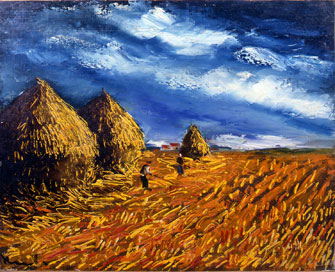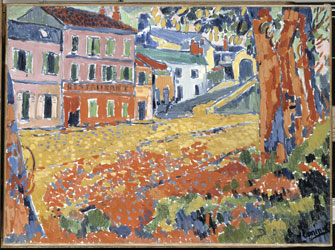Artist on the Move,
Literally and Figuratively

“Les Meules” (1943), by Maurice de Vlaminck. © Photo Archives Wildenstein Institute, Paris/ADAGP Paris 2015
The work of Frenchman Maurice de Vlaminck (1876-1958), now on show at the Atelier Grognard in Rueil-Malmaison, just outside of Paris, is hard to classify because of the artist’s individualism and his penchant for constantly changing his style and aesthetic.
The self-taught painter was suddenly introduced into the world of the Fauvists when he bumped into André Derain on a railway station platform in 1900. Trains to Paris were not running on that day, the story goes, and the two painters had a long walk together to Vélizy, where Vlaminck’s mother lived.
Embracing wholeheartedly the color-drenched Fauve style his friend was advocating, he contributed pictures to the 1905 Salon des Indépendants and to the Salon de l’Automne, along with Kees Van Dongen, Henri Matisse and Derain. An art critic coined the term Fauve (wild beasts) to describe the movement, whose adherents used pure, contrasting colors and smeared paint onto the canvas straight from the tube, producing work that is, above all, dazzling in its intensity.
Vlaminck’s pictures from his Fauve period have sold for up to $5 million apiece in recent years, particularly on the Japanese market. The artist’s lifetime output was prolific – at least 6,000 paintings and drawings are known to exist – but pictures from the later years are not worth anything like the price mentioned above. When they come up at Paris auctions, as they do fairly regularly, they fetch just a few thousand.
One of the few works from this pre-World War I period on show at the Atelier Grognard is the delightful “Le Restaurant de la Machine à

“Le Restaurant de la Machine à Bougival” (1905). © Paris/ADAGP Paris 2015, photo, RMN Grand Palais/Hervé Lewandowski
Bougival.” In his memoirs, he wrote: “Looking for the maximum color, I squashed and crushed tubes of blue and vermilion. I wanted to make it as hard and intense as I could.”
Although he soon tired of the Fauvist craze, it made Vlaminck’s reputation. By 1906, he had been adopted by the avant-garde art dealer Ambroise Vollard, assuring the artist of respectable fees for his output.
Unusually, Vlaminck rarely sketched in a notebook to compose his pictures while out and about along the banks of the Seine or in the French countryside. Documents from the artist’s studio show that he used picture-postcard views to provide the general framework, relying on his visual memory to complete the painting in his studio.
As a personality, Vlaminck was a burly, larger-than-life figure. In his youth he had been an enthusiastic sports cyclist, almost reaching a professional level before he was stopped by illness. He was also keen on weightlifting; we see him towering over his fellow recruits in a photo taken when he was called up for army training in 1898.
Like his father, he was an accomplished violinist. Performing and teaching music provided him with much-needed income in the early years. He spent his military service marching with the regimental band.
When the 1914-18 war broke out, Vlaminck was judged unfit for service and assigned to work in a munitions factory producing artillery shells. Two interesting paintings in the Cubist style in the exhibition show slanting chimney stacks and the jagged industrial cityscape of Puteaux in the western Paris suburbs.
Always the individualist and experimenter, Vlaminck moved on to another style showing signs of Cézanne’s influence, but he soon dropped this current and imposed his own approach in countless views of villages and country scenes, reflecting his contented life in the rural Val d’Oise northwest of Paris.
Incidentally, the picturesque riverside town of Auvers-sur-Oise, located nearby, had been a well-known artists’ colony since the end of the 19th century. It was here that Van Gogh stayed and painted wonderful pictures of wheatfields before shooting himself in obscure circumstances on February 22, 1890. Vlaminck, a huge fan of the Dutch painter, alludes to the place in his writings, marveling at the vista of the meadows where Van Gogh painted, just outside the village.
By the early 1920s, Vlaminck was beginning to enjoy a worldwide reputation, with exhibitions in New York (Brummer Galleries, 1922), Japan, London and Brussels. In 1925, he moved to a purpose-built house and studio at Rueil-la-Gadelière near Chartres and, the records tell us, purchased a motorcycle.
With this machine, and later in an open-top car, he enjoyed speeding around the French countryside – experiences that influenced his paintings in the late 1920s and ’30s.
In “Champ de Blé” (1930), “Paysage” (1930) and “Chaumières” (1933), we can discern the impression of speed on a country road, boldly pictured as the artist travels past villages and cornfields against a looming sky.
Vlaminck was the author of several books during his lifetime, including three novels and a diary with reflections about life, Le Chemin qui Mène à Rien (1936). His independence, contempt for the art establishment and rejection of intellectual posturing is clear from his writings. He raged against industrialization, which he equated with barbarism, and by the 1930s was viewed as an eccentric anarchist.
Against this background, he was very naive to let himself be persuaded in 1941 to join the notorious party of French artists who traveled from German-occupied Paris to Berlin. The “cultural delegation” had been invited on a study visit to the German capital by the Nazi propaganda minister, Joseph Goebbels.
The postwar excuse he gave was that this was part of a deal in exchange for the liberation of a group of captives held in Germany. This misguided action did not seem to damage his reputation.
By the late 1940s and ’50s, Vlaminck was perceived as a survivor from an earlier golden age of art. He continued to produce landscapes and still lifes, inventing new effects with the aid of modern paints and inspired by the emotional experience of walking in wheat fields, which “recall to me the strolls I took with my father when I was seven years old, the sheaves stretching high above me against a huge blue sky,” as depicted in “La Moisson sous l’ Orage” (1950) and “Les Meules” (1945-50).
The artist died on October 11, 1958, aged 88, at his rural studio home “La Tourillère.” At his funeral, the coffin was carried on a farm cart drawn by oxen. Flowers from the meadows of the nearby countryside were scattered on his grave.
The exhibition presents one hundred artworks, including many landscapes, brought together from museums all over France and from private collections.
Disappointingly, only a handful of Vlaminck’s early Fauvist works are on show. Officials from the Town Hall admitted that it had proved difficult to achieve an overall view of the artist’s career. The curator told me that she had visited Vlaminck’s studio near Chartres, which has remained virtually untouched since his death. What a shame that part of the studio couldn’t have been shown in the exhibition so we might appreciate how he worked. Instead, we have to be content with a few blown-up photos and two self portraits showing the genial artist in his battered hat and trademark silk scarf.
Atelier Grognard: 6, avenue du Château de Malmaison, 92500 Rueil-Malmaison. Tel.: 01 47 14 11 63. Open daily, 1:30pm-6pm. Admission: €6. Through May 25. www.mairie-rueilmalmaison.fr
Reader Richard Ewen writes: “Enjoyed James Overton’s very thorough article on Vlaminck. When I was in art school searching for my direction, I really loved the Fauve movement. Having started in drawing and design before being allowed to study oil painting, I was envious of Vlaminck’s colors and bold strokes. When I tried to emulate him, I fell flat on my face with muddy color. I never followed his later career or paintings, and your article has renewed my interest. I’m sorry I won’t be in Paris to see this exhibit, but I know visitors who take the time to go to Château de Malmaison and Atelier Grognard will find themselves in a very colorful and enjoyable atmosphere.”
Reader reaction: Click here to respond to this article (your response may be published on this page and is subject to editing).
Please support Paris Update by ordering books from Paris Update’s Amazon store at no extra cost. Click on your preferred Amazon location: U.K., France, U.S.
More reviews of Paris art shows.
© 2015 Paris Update
Favorite